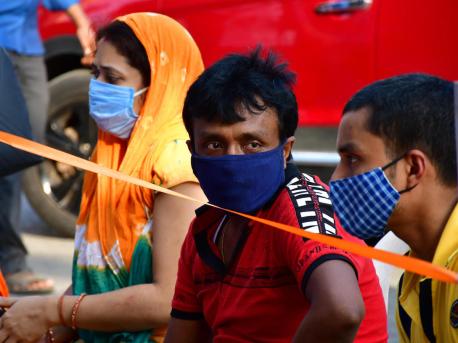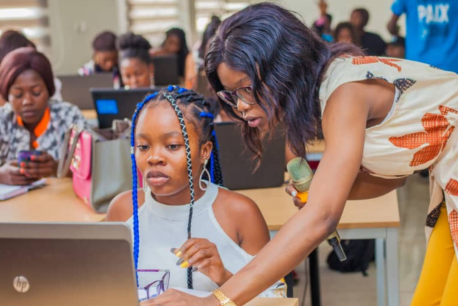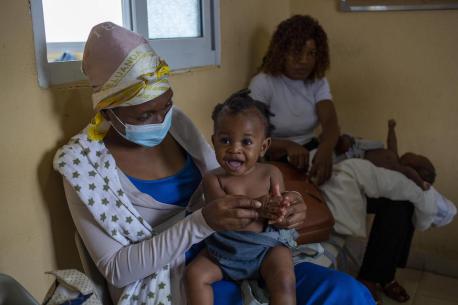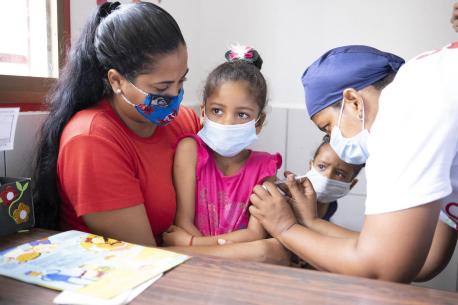
A Year Later, the Eerily Familiar Sounds of the Pandemic
The locations may change, but the mournful sirens and the agonizing wait for news of loved ones battling COVID-19 are universal. UNICEF staffer Sonia Sarkar reflects on the pandemic from NYC to Delhi, and what UNICEF is doing to protect the world.
March 2020. India had recently completed a massive vaccination campaign of more than 300 million children against measles and rubella – two potentially life-threatening diseases. I was posted to New York City for a health communications assignment which involved sharing my experiences from the public health communication drive that had helped make the campaign a success.
I remember getting ready to leave the office early that day. An article came up when I was reading about a new strain of pneumonia that was reportedly spreading in China. But it wasn’t the text of the article that was the most striking – it was the half-page picture of hundreds of beds lined up in a large hall. It looked like a picture from World War I.
Returning from lunch another day, I took the elevator to the Communications floor at UNICEF headquarters. But it was empty. On reaching my desk, I was told that the offices had been vacated – someone on the floor had been diagnosed with COVID-19.
That night, and for several nights later, the sirens of ambulances would tear through the night. COVID-19 was wreaking havoc in New York.
That night, and for several nights later, the sirens of ambulances would tear through the night. COVID-19 was wreaking havoc in New York. The TV was filled with horrific images of patients being brought to hospital and local officials pleading for support and additional personal protective equipment for health care workers. There was an acute shortage of ventilators.
Spring had arrived in New York. Pink flowers lined the road under bright blue skies. But the images that I remember from that spring are extremely sad. A teenager mourning the sudden death of her parents. Of the elderly, who were being most affected. Of glass panels separating the elderly from their grandchildren in hospitals. Of empty playgrounds.

On May 2, 2021, a patient receives treatment in a banquet hall, temporarily converted into a COVID-19 emergency ward in New Delhi, India. © UNICEF/UN0456998/Singh
I’m in Delhi now. The sound of ambulance sirens fills the night once again. Across the city and country, there are frantic messages and calls from desperate friends and family members. Phones beep, each time bringing hope that this could be that one message you have been waiting for – that one message that someone has managed to find a hospital bed or an oxygen cylinder for a loved one.
A year later, and TV screens are once again filled with images of people gasping for breath, their weakened lungs attacked by COVID-19. Hospitals overflowing with patients. It feels like COVID-19 has struck back with a vengeance, mutating as it has continued to spread around the globe, exploiting the complacency that had set in among many.
I'm in Delhi now... A year later, and TV screens are once again filled with images of people gasping for breath, their weakened lungs attacked by COVID-19.
I had noticed more masks resting on chins, even in crowded markets. People were again crowding onto the metro, eager to move back to ‘normal life.’ Working as a focal point for the Communications division and supporting the government, I knew there were a series of Jan Andolans or People’s Movement campaigns for masking, handwashing and social distancing that had been launched. But fatigue had gradually set in, and as hope spread with the arrival of effective vaccines, the ticker messages that flashed across TV screens – ‘Stay away from crowds, wash your hands regularly, wear a mask’ – were increasingly going unheeded.

A health worker inoculates a man with a dose of the COVID-19 coronavirus vaccine in a school-turned-vaccination center in New Delhi, India on May 5, 2021. © UNICEF/UN0458595/Singh
I understood people wanting to get back to normal. At home, my teenage daughter’s social media conversations with friends were increasingly focused on getting back to in-person studying and classes. After all, this was her last year in school and she felt that things like complex physics formulas would be much easier to grasp if the teacher was explaining them face-to-face.
As more people let their guard down and the virus mutated, COVID-19 found new opportunities to gain ground over the past few weeks and months. State after state started reporting more cases. First it was the financial and industrial hubs in Maharashtra, then came news of the high transmission rates in Punjab and Chhattisgarh. As the pace of infection rates increased, so did the need to ramp up communication. More teams were pressed into action.
As the COVID virus surge turns more severe, our communication teams are working alongside government, reinforcing COVID-appropriate behaviors, busting dangerous myths and urging communities to vaccinate and protect themselves.
As cases soared, lockdowns started. People started to panic-buy and hoard essential medicines and oxygen cylinders. Hospitals, meanwhile, started running low on oxygen and antivirals.
Keeping pace with the rapidly spreading wildfire of misinformation hasn’t been easy. We have watched it spread through ‘dark social,’' family and resident’s association groups and youth networks. While frontline workers in hospitals have been battling to save lives, we have been battling dangerous misinformation about COVID-19 in India, sending out critical public health messages and encouraging people to get vaccinated to help slow the pandemic.
By early April, I came to know I had caught COVID again. I continue to support the teams as much as possible. As the COVID virus surge turns more severe, our communication teams are working alongside government, reinforcing COVID-appropriate behaviors, busting dangerous myths and urging communities to vaccinate and protect themselves.
You can help UNICEF rush COVID-19 vaccines and lifesaving supplies and information to protect health workers, families and communities in India and around the world. Please donate today.
Sonia Sarkar is Communications Officer (Media) at UNICEF India.
Top photo: On May 8, 2021 in Jogeshwari, a suburb located in the western part of Mumbai, people wear masks to prevent the spread of COVID-19 as India's catastrophic second wave continues. © UNICEF/UN0459615/Koyande
HOW TO HELP
There are many ways to make a difference
War, famine, poverty, natural disasters — threats to the world's children keep coming. But UNICEF won't stop working to keep children healthy and safe.
UNICEF works in over 190 countries and territories — more places than any other children's organization. UNICEF has the world's largest humanitarian warehouse and, when disaster strikes, can get supplies almost anywhere within 72 hours. Constantly innovating, always advocating for a better world for children, UNICEF works to ensure that every child can grow up healthy, educated, protected and respected.
Would you like to help give all children the opportunity to reach their full potential? There are many ways to get involved.





